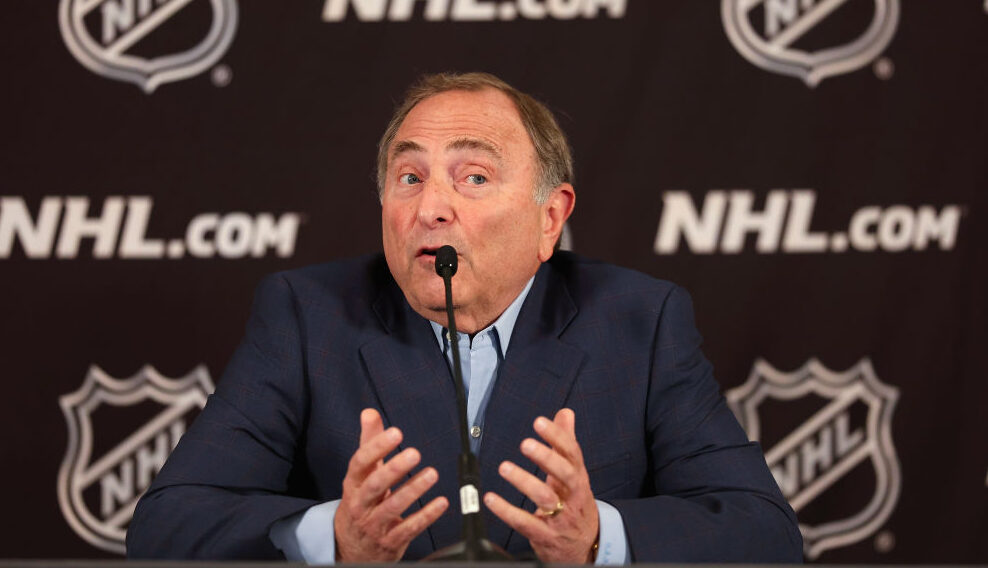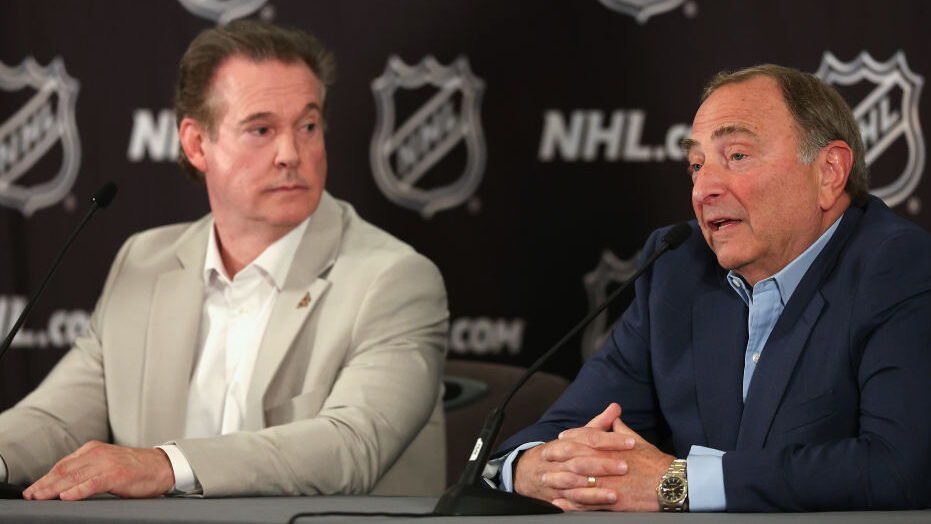Busting some myths about Coyotes coach Dave Tippett
Nov 4, 2015, 4:15 PM | Updated: 5:38 pm

Arizona Coyotes head coach Dave Tippett looks up towards the scoreboard after Boston Bruins left wing Brad Marchand scored during the third period of an NHL hockey game in Boston, Tuesday, Oct. 27, 2015. The Bruins defeated the Coyotes 6-0. (AP Photo/Charles Krupa)
(AP Photo/Charles Krupa)
GLENDALE, Ariz. — The show, MythBusters, uses scientific methods to test the validity of rumors, myths or claims. Maybe the show’s hosts, Adam Savage and Jamie Hyneman, could dispel a pair of persistent myths about Coyotes coach Dave Tippett.
A couple years into his Arizona tenure, Tippett became known as a defensive coach, a guy who wouldn’t know what to do, or how to succeed with an abundance of skill and offense. Around the same time, he gained a reputation as a coach who didn’t trust young players.
“I think it got going when I came here because we had young players who weren’t ready to play in the league but they had played in the league already,” Tippett said, referring to such players as Kyle Turris, Peter Mueller and Mikkel Boedker, who were infamously rushed to the NHL by the previous regime. “Everybody tells me ‘you don’t like young players.’ Well, at that time, we were trying to save a franchise and make it competitive again. What was happening in the past wasn’t working.”
Within three seasons, Tippett took a veteran-laden team to the Western Conference Final and energized the local hockey community like never before. That team relied on a strong blue line and the goaltending of Mike Smith, so let’s start with that first myth about Tippett: that he is a defensive-minded coach who struggles with offensive players.
“I think that’s a horse(expletive) rumor,” said Hall of Fame center Mike Modano, who played for Tippett in Dallas from 2002-2009. “Being around him for so long and hearing his philosophy on the game and how it’s played, I can tell you he loves nothing more than a skilled player. Like any coach, he just wants his skilled players to have a little bit of responsibility and roundness to their game, rather than being one-dimensional.”
Tippett’s Dallas years fly in the face of the notion that he can’t coach offense. In three of Tippett’s first five seasons in Dallas, the Stars finished among the NHL’s top nine teams in scoring because they had the personnel to do so with players such as Modano, Jere Lehtinen, Bill Guerin, Brenden Morrow, Jason Arnott, Sergei Zubov, and later, Mike Ribeiro and Loui Eriksson. In the 1998-99 season, while coaching the IHL’s Houston Aeros, Tippett led his team to the Turner Cup and the Aeros scored a league-leading 307 goals — 22 more than any other team.
New York Rangers coach Alain Vigneault laughed at the perceptions that sometimes exist about coaches due to the personnel and situations they are dealt. Vigneault believes most NHL coaches preach a very similar style, making adjustments when the personnel they have dictates such tweaks.
“I know that Dave Tippett is the same way as I am,” Vigneault said. “We don’t like to trade chances. You’ve got to be able to play at both ends.”
That demand holds for young players as well. As Tippett noted, when he arrived in Arizona in 2009, the franchise was going through bankruptcy and eventual NHL ownership. The Steve Ellman-Jerry Moyes-Wayne Gretzky-Mike Barnett leadership had failed on a number of fronts, including putting young players who weren’t ready to play in the lineup.
“I thought it would benefit them to learn the game more in the minors and then come up,” Tippett said.
Coyotes rookie Max Domi is the poster boy for that philosophy. While fans and some analysts thought Domi belonged in the lineup last season, Tippett and GM Don Maloney elected to send him back to London of the Ontario Hockey League to work on some of the details of the game he’d need to succeed in the NHL, including his defensive responsibility, his play without the puck and his decision making with it.
Domi has said repeatedly that the extra year in juniors benefited him enormously. At age 20, he is averaging 17:02 of ice time, which ranks fifth among Coyotes forwards, and that figures to rise as Tippett gains even more trust in in his rookie-of-the-year candidate.
“There are situations you get into in a game where you sometimes balance the experience factor over youth; critical situations in a game where you take a veteran defenseman vs. a young defenseman because a veteran defenseman has been in that situation and you’re trying to win a game,” Tippett said. “But there might be situations — and I’ve done it certain times already this year — where we have to see how a young player reacts in a situation. You’re not sure what you’re going to get but you’ve got to get them that experience.
“Putting Max on at the end of the game with a lead (Oct. 24) in Ottawa is an example. It was the last two minutes of the game with their goalie pulled. It was a learning experience for him and he played very well, protected the puck very well. He ended up making a good play on Boedker’s (empty-net) goal. When you have a guy who has earned the right to try that, you have to give him that new experience in order for him to grow as a player.”
One of the four forwards who ranks ahead of Domi in ice time is 22-year-old Tobias Rieder, who was the training camp surprise last season and has earned Tippett’s trust so much that he plays in all situations.
“When I hear people say he doesn’t trust young players — for me it’s been the total opposite,” Rieder said. “Just look at our lineup this year with Max and Duke (Anthony Duclair). I think he’s shown it doesn’t matter how old you are. If you can get the job done he’s going to put you on the ice.”
Playing Tippett’s style doesn’t mean forfeiting offensive creativity. On the contrary, Domi said Tippett encourages certain players to freelance at the offensive end because those players are the ones counted on to produce the most.
“We’ve had that exact conversation,” Domi said. “He’s said, ‘listen, there are times that you’re going to have to chip the puck in and push the game along a little bit and there are times when I want you to make the play. Obviously, you’re not going to make a successful play every time. You’re going to turn pucks over and I understand that but as you grow as a player you’re going to have to learn when the time is to do that.
“That’s the biggest thing for me, that sense of comfort and trust he has in me and that understanding that that’s what my game is. At the same time, he’s trying to teach me when I shouldn’t be doing those things so it’s been a great relationship.”
Domi’s conversations with his coach highlight one of Tippett’s greatest strengths: his ability to communicate with and relate to a wide variety of personalities.
“He’s one of the more personable coaches I’ve ever had,” 23-year-old forward Jordan Martinook said. “He’s so easy to talk to and the great thing about Tip is it’s not always just about hockey. He genuinely wants to get to know you and what you’re all about. One of the main things for me is building a good relationship with my coach and I definitely have that with him.”
Tippett takes the same approach with most of his players, but he believes he has a greater responsibility to the young ones in this department.
“There’s a lot of learning going on,” he said. “When you coach veteran players you’re reinforcing things they have seen and heard already. With young players, new players in the NHL, just about every day is a new experience for them.
“You’ve got to monitor everything very closely with young players; make sure they know what’s expected of them, make sure they’re held accountable to certain standards and make sure they’re learning.”
Critics might say that Tippett was forced into playing young, skilled players by an organization whose philosophy has changed. A stagnant salary cap and the increasing emphasis on speed are also contributing to a youth movement across the league. Tippett acknowledged those realities, but scoffs at the notion that he is playing guys he doesn’t want to play. He is on board with the Coyotes’ current movement. One month into the season, he’s just trying to figure out how the pieces fit.
“Any coach will look at the players they have at their disposal and say, ‘how do we win with this group and how do we grow with this group?'” Tippett said. “Young players, old players, in-between players. I don’t care. Coaches just want good players.”
Avalanche at Coyotes
When: Thursday, 7 p.m.
Where: Gila River Arena, Glendale
TV: FOX Sports Arizona
Radio: ESPN 620 AM
Injury report: Avs — C John Mitchell (oblique) is day to day. C Jesse Winchester (head) is out indefinitely. Coyotes — C Antoine Vermette (lower body) and D Stefan Elliott (upper body) are day to day.
Scouting the Avs: Colorado defeated Calgary on Friday but the Avs still sit a distant last in the NHL’s best division, the Central…. C Nathan MacKinnon leads the team with 13 points (five goals) but G Semyon Varlamov has struggled with a 3.29 goals against average and a .890 save percentage.






